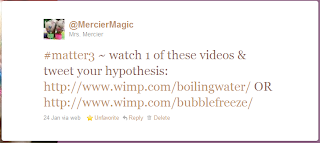Why Use Social Media?
This is a pretty common question that I hear when I speak about digital citizenship, and its usually followed with because the whole point is to socialize. When I hear people say this I hear a lot of fear. Fear of losing control. Fear that their students will engage inappropriately. Fear of repercussions from administration, parents, and the community. Understandable, because no one likes to feel afraid, and outside of the fact that you should define social media for yourself so that you have a purpose for using it and then know what you expect of your students while they are using it. So why use social media when students will be socializing?
Because it is social. The greatest cognitive growth occurs through social interaction. There is an abundance of research that proves this and it is one of the principles in the Responsive Classroom philosophy. People, including children, learn best when they are exchanging ideas with others. It strengthens their understanding, helps them clarify misconceptions, and opens them to diverse opinions and experiences. All of these things happen in a classroom when students are working in small groups, but provides the opportunity for this to occur in an exponential way when happening online.
Using social media with students gives them the opportunity to practice social skills. The same social skills we teach and expect students to use when engaged with others in person, we expect them to use online. At the same time, we have to teach them new skills that involve social critical thinking. For example: if I say _____ I am trying to say _____, but someone could think I mean ______ so I should say ______ instead. We are teaching them critical literacy tools that are necessary in the absence of body language and intonation. We are teaching them word choice, tone, intent, and perception. But, most importantly, we are teaching them empathy.
While novelty is key in some ages, early adolescents in particular, relevance is important to any learner. Social media hits both of these. Using tools that students are familiar with is one important way to engage students in curriculum. This also tells them that we validate their lives outside of school, creating a sense of significance, and making them more apt to participate in curriculum that could be unappealing or challenging. Then there is the novelty. Tools like Facebook, Twitter, YouTube, and more are used by students of all ages for social reasons. Using them in the classroom is novel because we are using it a way that is foreign to them: to learn.
Because it is social. The greatest cognitive growth occurs through social interaction. There is an abundance of research that proves this and it is one of the principles in the Responsive Classroom philosophy. People, including children, learn best when they are exchanging ideas with others. It strengthens their understanding, helps them clarify misconceptions, and opens them to diverse opinions and experiences. All of these things happen in a classroom when students are working in small groups, but provides the opportunity for this to occur in an exponential way when happening online.
Using social media with students gives them the opportunity to practice social skills. The same social skills we teach and expect students to use when engaged with others in person, we expect them to use online. At the same time, we have to teach them new skills that involve social critical thinking. For example: if I say _____ I am trying to say _____, but someone could think I mean ______ so I should say ______ instead. We are teaching them critical literacy tools that are necessary in the absence of body language and intonation. We are teaching them word choice, tone, intent, and perception. But, most importantly, we are teaching them empathy.
While novelty is key in some ages, early adolescents in particular, relevance is important to any learner. Social media hits both of these. Using tools that students are familiar with is one important way to engage students in curriculum. This also tells them that we validate their lives outside of school, creating a sense of significance, and making them more apt to participate in curriculum that could be unappealing or challenging. Then there is the novelty. Tools like Facebook, Twitter, YouTube, and more are used by students of all ages for social reasons. Using them in the classroom is novel because we are using it a way that is foreign to them: to learn.

Comments
Post a Comment